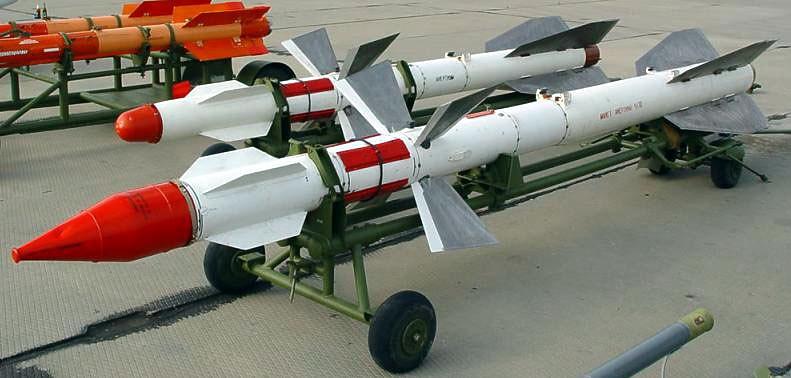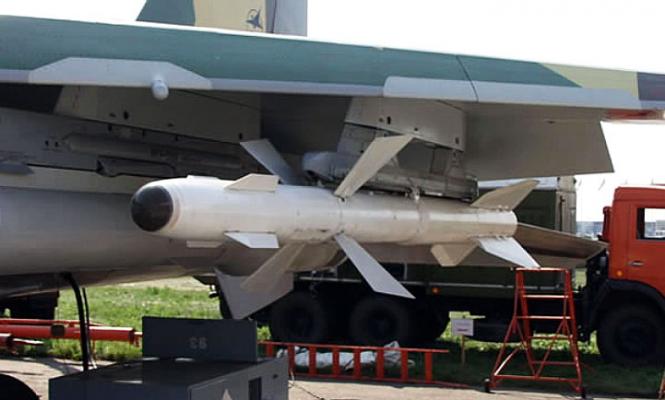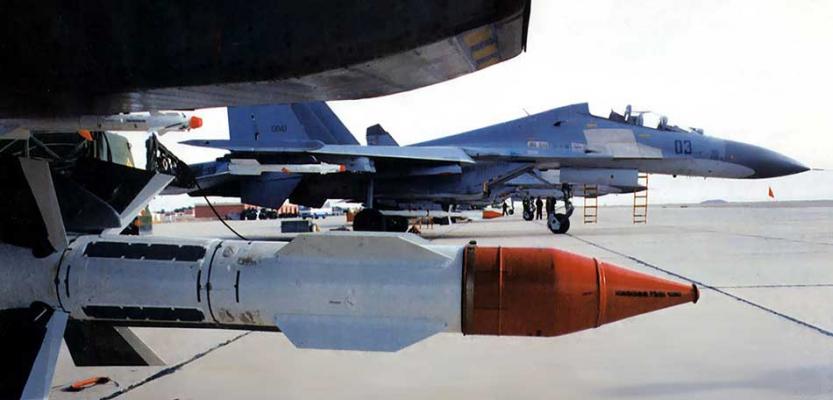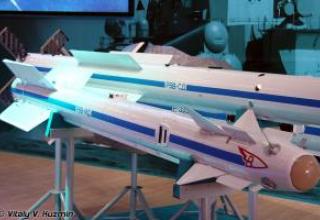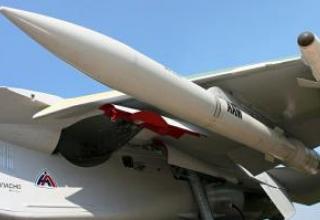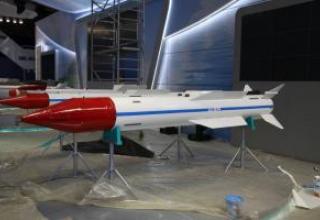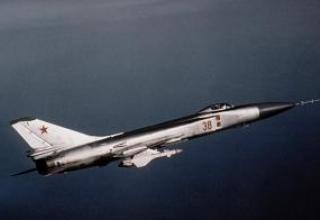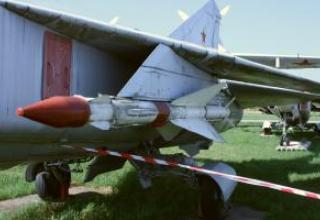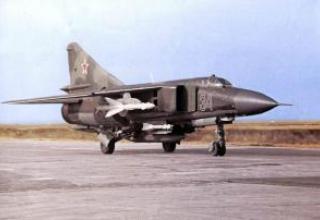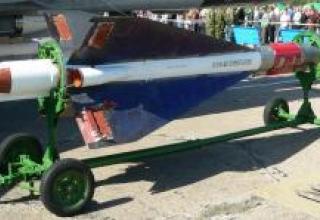In accordance with the decision of the CPSU Central Committee and the USSR Council of Ministers dated 26th June 1974, development work on the fourth generation fighters - the future MiG-29 and Su-27 - was launched.
In the same year, Vympel Design Bureau prepared technical proposals for a new K-27 missile (product 470) designed to arm these promising aircraft. The development of the K-27 was entrusted to a team headed by A.L. Lyapin; the design was led by P.P. Dementiev and V.T. Korsakov.
The prospect of simultaneous development of two fighters of almost identical purpose as early as at the stage of the technical proposal in 1974 prompted a fundamental decision to create a system of unified missiles: K-27A for the light MiG-29 and K-27B for the heavy Su-27. It was assumed that the missile versions would differ in terms of propulsion systems and, accordingly, launch range. On the basis of established practice, it was considered appropriate to provide for each version of the missile with different propulsion systems, with a "radius" and "thermal" CNS. This was the definition of the concept of a "modular" missile with variable COS and propulsion systems.
It seemed very tempting to achieve interchangeability of propulsion systems by eliminating cable and gas connections of control equipment and gas generator in the central unit with the tail of the missile. However, the adopted scheme "duck" traditionally associated with the need to place in the tail of the steering machines drive aileron control. The fact that the front position of the rudders their deflection generates a bevel of air flow affecting the wings installed in the tail in such a way that a certain combination of angles of deflection of rudders, angles of attack and sliding, the phenomenon of reverse control on the roll - the moment from the aerodynamic forces on the wings acts in the direction opposite to the moment from the forces on the steering wheel, and exceeds it. Therefore, on almost all missiles made by the scheme of "duck", the rudders serve only to control the pitch and yaw, and on the channel of the roll are used either stabilizing ailerons or rollers, limiting the speed of rotation of the rocket on the roll.
Vimpel's designers managed to provide control of the rocket through all channels with differentiated deflection of the rudders, abandoning ailerons. For this purpose the K-27 used uniquely shaped butterfly wheels. The adopted scheme was not unanimously approved. Thus, according to specialists of NII-2 (now GosNIIAS), the conditions of application of K-27 more corresponded to the "normal" scheme with the placement of the rudder to control the rocket in its tail part. In this case the resistance was reduced at small angles of attack and the aerodynamic quality was increased. However, the normal scheme required the control elements to be separated between the nose and tail sections of the missile, which violated the modular design principle. Unification of the missile's tail compartments with engines of different diameters was also called into question. That is why Vimpel's designers also worked out a "normal" scheme, but, relying on the support of TsAGI, kept the scheme chosen by them - something intermediate between the "duck" and "rotary wing".
Fundamentally new technical solutions were also used in the missile's onboard equipment. In the implementation of conventional semi-active CNS on promising Soviet missiles could not achieve superiority over the "Sperrow" AIM-7M, as domestic aircraft radars and CNS missiles were inferior to the U.S. counterparts on the backlighting potential and sensitivity of the receiver. Therefore, in the course of development for missiles with radar GSN specialists NIIP based on the results of research adopted a combined scheme of operation with the ability to capture the target on the trajectory. It should be noted that the "Sperrow" used a more primitive technical solution: not even a simple inertial control without correction by radio, adopted on the R-24, and the starting, so-called "English" correction, similar to the scheme implemented in the R-23.
The final version was determined in 1976, when the sketch design was issued, reflecting the requirements of the decrees of January 19, 1975, which specified the requirements for MiG-29 and Su-27 respectively. The deadlines for submitting missiles for state testing were also set: 1978 for K-27 on the MiG-29 and 1979 for K-27E on the Su-27. The issue of equipping K-27 with MiG-23 aircraft was also studied. The next year, 1977, was marked by the first flights of the MiG-29 and Su-27 prototypes along with protection of the conceptual design, as well as by the start of full-scale testing of the missiles - two launches of ballistic "products 472" from a ground-based launcher.
The initial testing of the Rubin radar and missile homing heads was conducted at the LL-124 flying laboratory, created on the basis of the Tu-124. At the initial, autonomous flight testing stage, four ballistic and two program missiles were launched in early 1979 with the MiG-21 bis ¹ 116. A little later in the same year, and the first launches of six program and two telemetry K-27 with the modified MiG-23ML number 123. At the same time, two program and three telemetry launches of K-27E with Su-15T ¹02-06 (the so-called LL 10-10, more than MiG-23, adapted for the heavy version of the missile) were performed.
In accordance with the decision of the military-industrial complex of January 31, 1979, the issues of using radiocorrection on the inertial flight section of K-27 were considered. Design studies were also conducted to determine the possibility of a significant relief of the K-27 missile, but in those years they did not yield positive results for the "radium" version. TORs were developed for the lightweight thermal variant, but due to significant disaggregation with the rest of K-27 modifications, this direction was not developed.
The following year, the volume of flight tests increased many times. MiG-23ML was used to launch 22 program missiles, as well as six missiles with thermal GSN on parachute targets and La-17. Another 14 heat-seeking missiles were launched on similar targets with LL 10-10 (Su-15T), having completed rocket tests on this flying laboratory in 1980. State testing of the thermal version of the rocket began in May 1980. on the third pilot, not yet equipped with radar, MiG-29 number 902 (aka 912/3). This lack of equipment did not prevent the testing of the missile with a thermal CNS.
In 1981, autonomous launches from the flying laboratory of the MiG-23ML began the factory phase of testing the "radium" rocket. Later tests were carried out on the MiG-29 ¹ 918 - the first complete radar, from which the first shot down an air target. However, the radar overflights brought an unpleasant surprise. It turned out that with the installation on the MiG-29 its detection range turned out to be almost a third less than the specified one.
The design and development of the "radium" missile with a catapult version of the launcher AKU-470, as well as field development of AKU-470 in ground conditions. Thermal version of the missile continued to be tested: nearly four dozen launches of software and telemetry missiles, including La-17, were conducted. The first thermal launches of La-17 missiles were also made from the Su-27 prototype, the T-10-4 aircraft.
The following year, 24 more missiles of various configurations were launched, including three combat missiles, completing the first stage of state trials on the MiG-29. In 1983, it was mainly possible to carry out the second stage programme on both MiG-29 (launches were made from aircraft No 902, 919 and 920) and the Su-27. In 1983, another 39 launches of K-27 and 66 of K-27E were made. In addition, a special programme on the MiG-29 No 921 examined the engine stability during rocket launches. The state tests were completed in 1984. Both versions of the K-27 rocket were adopted for service in 1987 under the designation of R-27R and R-27T.
The large volume of tests of the K-27 family of missiles, in addition to the novelty of the problems solved, was determined by the fact that the MiG-29 and Su-27 carried different radio electronic systems with different mathematical support. The correctness of the algorithms had to be verified by actual use of the missiles, which increased the testing volume by dozens of launches.
It is well known that already after the start of testing the T-10 (the Su-27 prototype), it was decided to make major changes to the design, actually corresponding to the development of the aircraft almost all over again. In particular, the main decisions on the onboard radar were radically revised as well. The new versions of the K-27 were developed by MiG-29 (No 920) from June to September 1984.
Testing of the K-27E rocket was somewhat delayed and accompanied by the introduction of modifications to the CNS, inertial system, radio command line equipment. Only in 1990 the missile was adopted for service in the versions of R-27ER and R-27ET. Production was launched at the Artem Plant in Kiev.
In general, the developed missile armament had an advantage over the Sperrow AIM-7F in terms of launch range, achieved through the implementation of inertial guidance area. The modular principle of building a family of missiles allowed to create modifications of missiles with enhanced energy capabilities, in the reach of approaching modern long-range missiles and have high efficiency in combat at medium and short distances due to the high average speed of flight. The creators of the missiles were awarded the State Prize in 1991.
Export versions of R-27R-1 and R-27T-1 missiles were produced in connection with deliveries abroad of MiG-29A from 1988 and MiG-29B from 1986, while R-27ER-1 and R-27ET-1 were produced in connection with deliveries abroad of Su-27 in the 1990s.
It is envisaged that R-27 family rockets will also be used on earlier models of second and third generation fighters after their comprehensive upgrade, in particular, on the MiG-21-93 project.
In addition to the four main versions of R-27ER missiles, a K-27P missile with a passive homing head was also created. The work began under the decision of the MIC of August 18, 1982. Even earlier in the Omsk Central Design Bureau (former Design Bureau-373), the team led by G. Bronstein designed the GSN, and in 1981 there was a draft design. Preliminary tests were conducted in 1984-1985 mainly on MiG-29 ¹970 and 971. The tests were completed with a positive result in 1986, with recommendations for the adoption and serial production. Tests of the K-27EP as part of the Su-27 weaponry were conducted from 1986 on aircraft No 10-21, 10-22, 10-23, 10-31, 10-32 and were completed in 1989. The missile was not offered to the foreign market for a long time, but in 2004 it was demonstrated at the Fidae-2004 exhibition.
A number of aircraft showrooms presented materials on the variant of the R-27EA missile with a combined guidance system. This variant uses CSS ARGS-27 - inertial, with radiocorrection and active radar self-direction at the end site, which ensures the principle of "shot and forgotten". Deployment of full-scale development works on this option began by the decision of the MIC of July 19, 1982. The draft design of the active CLO was released back in 1981. The most difficult task for its designers - employees of A.M. Sukhov's laboratory at the Agat Research Institute - was the creation of a small-size transmitting device with a power of 30-60 W with a multi-beam klystron as a vacuum output device.
The conceptual design for the R-27EA missile as a whole was completed in 1983. In 1984, for the application of K-27A were prepared MiG-29 ¹919, the next year - ¹ 925, but later these machines were used for more priority work - testing a promising missile RVV-AE. In fact, flight tests of K-27A were conducted on MiG-29 ¹ 970 and 971. In 1985 they performed three launches, the next year - five.
In the ARGS-27 it was planned to use Alice onboard digital computer on 588 series chips, but its development was so difficult that the use of other types of calculators began to be considered. Time was wasted, and in 1988-1989, due to reduced funding, research on the ARGS-27 was practically suspended in order to continue the work on CLO for the RVV-AE rocket. Nevertheless, the work in this area was continued by the Agat Research Institute on a proactive basis. As a result, it was possible to reduce the weight of this modification of the COS one and a half times - from 21.5 to 14.5 kg, as well as to increase the range of capture.
On the whole, the development of the K-27 family of missiles made it possible to implement to the fullest extent the principle of unification both for the armament of the "heavy" and "light" class fighters and for the creation of the most important elements of the missile, unified for the variants with different range and targeting principles. V.G. Karaskov, A.L. Reidel, P.P. Vasiliev, A.B. Prigornikir made a great contribution to the development of the rocket on Vimpel.
Abroad, this missile was named AA-10 Alamo.
Composition:
The P-27 missile is designed in a scheme that is intermediate between a "duck" scheme and a scheme with a swivel wing, with tandem-positioned stabilizers, rudders and wings (see projections).
In the forward part of the missile body (see the layout diagram) is placed COS. In the compartment behind it there is a radio detonator and autopilot. In the third compartment there is a power drive unit (turbogenerator, hydraulic pump drive and steering machines). The fourth compartment is the combat unit of shrapnel-phase or rod type with the weight of 39 kg (explosive charge weight - 15 kg). The fifth compartment houses a solid propellant rocket engine. Depending on the modification of the rocket it is possible to install the engine of one of two types: single-mode (diameter 230 mm, length 1500 mm) and double-mode (diameter 260 mm, length 2200 mm), providing increased range. The main material of the rocket design is titanium alloy. The compartments are docked by means of eccentric-type locking devices.
The modular missiles of the R-27 family have identical combat units, control and power supply units, carrying surfaces and rudders. Each of the modifications can be equipped with unified engines of conventional (R-27R and R-27T) and enhanced (R-27ER and R-27ET) power and guidance systems based on infrared CNS, as well as passive, semi-active and active radar CNS. The use of missiles with different homing heads increases the interference immunity and effectiveness of the weapon system of aircraft systems.
Aerodynamic rudders of large elongation, have a narrowing form to the base (the so-called "butterfly" scheme), which made it possible to use them in a differential mode both to control and stabilize the rocket on the main channels, and to stabilize it on the roll channel. The configuration of the rudders ensures the constancy of the roll moment sign in the whole used range of numbers M, ie, eliminates the so-called "reverse phenomenon" inherent in missiles scheme "duck", as the area of the most disturbed by the rudders air flow is referred to the missile body and has a minimal impact on the wings of small elongation, the swing of which is one and a half times smaller than the rudders. The rudders are located near the aerodynamic focus of the rocket, which provides direct control of the lifting force and makes it possible to intercept energetically maneuvering and altitude targets on the optimal trajectories.
The rudders are hydraulic powered by an on-board hydraulic pump. Homing heads are equipped with destabilizers in front of the steering wheels. When changing the homing heads the required stock of static stability is ensured by changing the area of the destabilizers.
In addition to the GSN, the R-27 missile control system includes a radio-corrected inertial navigation subsystem. At the initial section of the trajectory inertial guidance is applied to the "mathematical" target with radiocorrection of its position and speed during target maneuver (according to information from the carrier transmitted over the radio line). Target designation can be performed from the aircraft carrier's onboard radar, heat-pelenetrating or optoelectronic sights, from the pilot's helmet system. It is possible to launch the missile in the direction of the enemy aircraft with subsequent autonomous capture in flight. At capture of a target the information system of the carrier on the rocket gives out angular target designation. When the target is in the field of view of the coordinator of the missile provides capture and auto tracking of the target. In the absence of information from the launch vehicle is provided for the work of the rocket in autonomous mode, which is installed by the pilot from the cockpit. In addition to the main version of the flight with the implementation of the proportional navigation method may apply special modes of guidance, providing more favorable modes of operation of the CNS and the radio detonator.
The missiles are delivered to the troops in the assembled form (with the rudders and wings disconnected). The missiles are used from rail launchers AKU-470 or catapult AKU-470 (only modifications from radar CNS).
Modifications
R-27P (item 470-1) - with semi-active radar SNS 9B-1101K (see description). R-27P provides target acquisition in the range of heights from 20 to 25000m with maximum exceeding/lowering 10km at target speed up to 3500km/h and overload 8g at any initial position in the field of target designation angles equal to ±50°. It is possible to launch two R-27R missiles on two targets.
R-27ER (product 470-1E) - a variant of R-27R with an extended launch range (130 km instead of 80 km). In addition to the longer launch range, the altitude of the missile is increased to 27 km. During their testing, the maximum range was achieved up to 98 km. It is applied to MiG-29K, MiG-29M, MiG-29S, Su-27, Su-33, Yak-141.
R-27P1 and R-27ER1 are export versions of R-27P and R-27ER. According to the advertising information, the last R-27P1 variants have a range of 75 km when shooting at the rear hemisphere (RHF) and 50-60 km when shooting at the front hemisphere (RHF) on a fighter target. Similar parameters for the R-27ER1 are 90-100 and 60-62.5 km, respectively.
R-27T (item 470-3) - with thermal GSN 36-T. R-27T provides target engagement in the range of heights from 20 to 25000m with maximum exceeding/lowering 10km, target speed up to 3500km/h and target overload of 8g at any initial position in the field of target designation angles equal to ±55°. Time of continuous operation with the cooling system of the photoreceiver switched on - 3 hours. The infrared homing head provides for the system operation if there is no refrigerant carrier on board before takeoff (with decreasing range parameter).
R-27ET (product 470-3E) - variant of R-27ET with increased range of start. It is used on MiG-29K, MiG-29M, MiG-29S, Su-27, Su-33, Yak-141.
R-27T1 and R-27ET1 - export versions of R-27T and R-27ET missiles. According to advertising information, the last versions of R-27T1 have a range of 65 km when fired at PPS. For R-27ET1, the same parameter is 80 km.
R-27EA - with multifunctional monopulse Doppler active radar SNS 9B-1103M (see description). Range of fire at ZPS is 130km, at PPS - 60km.
R-27P - with passive radar CNS 9B-1102 (see photo). It is intended to engage DRLO and other radio-emitting airplanes at any time of the day, in simple and difficult weather conditions, in the front hemisphere, including the background of various underlying surfaces, providing defeat of aircraft that put the active interference radar to cover their aircraft. Explosive device - a radio detonator and contact target sensor. Battle unit - rod bearing type. The range of a typical target PRGSN 9B-1102 more than 200 km, which exceeds the ballistic range of the missile. The minimum range is 2-3 km, overload of affected targets - 5.5g. PRGSN 9B-1102 is produced by Omsk Automatic Plant OJSC.
R-27P, R-27EP1 - export versions of R-27P and R-27EP missiles (see photo1, photo2). The maximum launch range for R-27P and R-27EP1 is 72 and 110 km, respectively. Target acquisition height is 0.02-20 km.
R-27EM is part of the Su-33 armament and is used against Tomahawk and Harpoon anti-ship cruise missiles at a minimum altitude of 3m above the water surface. It is equipped with the ARGSN with a two-stage guidance system - inertial with radiocorrection with transition to active radar homing on the final flight section. Range of fire at the ZPS - 170 km, at the PPS - 110 km.
For training purposes they are equipped with R-27UT recorder with TGSN and R-27UD with RGSN.
Characteristics:
| R-27R | R-27Т | R-27ER | R-27EТ | R-27EА | |
| Range of fire, km: - maximum - minimum |
58 0.5 |
57 0.5 |
80 0.5 |
74 0.5 |
130 0.5 |
| Maximum flight speed, M | 4.5 | ||||
| Starter weight, kg | 253 | 245 | 350 | 343 | 350 |
| Weight BC, kg | 39 | ||||
| Dimensions, mm: - length - diameter - plumage scale |
4080 230 972 |
3795 230 972 |
4775 260 972 |
4490 260 972 |
4780 260 972 |
| Overloading of affected targets | 8 | ||||
| Probability of hitting the target | 0.7 | ||||
Testing:
Having unique flight and tactical characteristics, MiG-25P for a long time was operated only as part of the Soviet air defense fighter aircraft. In the early 1980s, its delivery abroad began, and soon its baptism of fire took place. Even before the beginning of the large-scale Lebanese conflict, in spring 1981, the Syrians announced the destruction of the F-15.
According to the Iraqi Air Force Command, from December 1982 to October 1986, during the Iran-Iraq war, the Iraqi MiG-25 shot down an Iranian F-5E fighter, an EU-130E counter-electronic aircraft, and three Phantoms, including one in a reconnaissance version.
During Operation Desert Storm, January 17, 1991, Iraqi MiG-25 managed to shoot down an American F/A-18, and in 2002 - an unmanned reconnaissance drone Predeitor.
Sources:
- Марковский В.Ю., Перов К. Советские авиационные ракеты "воздух-воздух". - М.: "Экспринт", 2005. - С. 38-42.
- ОАО МНИИ "Агат" /Радиолокационные головки самонаведения для ракет класса "воздух-воздух" и "поверхность-воздух"/
- AA-10 Alamo - R-27
- Отечественные ракеты "воздух-воздух"
- МАКС-2005.14-08-2005. | Евгений Ерохин
- AA-10 "Alamo" (Vympel R-27)
- AA-10 Alamo - R-27
- The Russian Philosophy of Beyond Visual Range Air Combat
- Ракеты Р-27П1, Р-27ЭП1
- Управляемые ракеты класса "воздух-воздух" Р-27Р1, Р-27ЭР1
- Виталий Кузьмин: Фотоархивы
